Ahead of this game, Marco Rose’s team got seven points out of their first four games. Their only loss was in the game against RB Leipzig which are after the fifth matchday in the first position of the Bundesliga. It was clear that Borussia Monchengladbach would need some time to adapt to the ideas of their new coach and so the start into the Bundesliga season was as expected.
However, their 4-0 loss against the Austrian team Wolfsberger AC on the first matchday in the Europa League came out of nowhere and shocked many football fans. In light of this, it was interesting to see the reaction of Rose’s team in the game against Fortuna Düsseldorf.
Friedhelm Funkel’s team, on the other hand, got four points out of their first four games and were in a comfortable 11th position. Last season Düsseldorf was able to win one of the two matches in the Bundesliga against Gladbach, but they lost the other one.
This tactical analysis will look at both teams’ tactics and how Gladbach was able to get away with a 2-1 victory after a thrilling closing phase.
Lineups
As we will see later in this analysis, the formations and systems of both teams weren’t utilized as many media houses reported but anyway, we will quickly go through them.
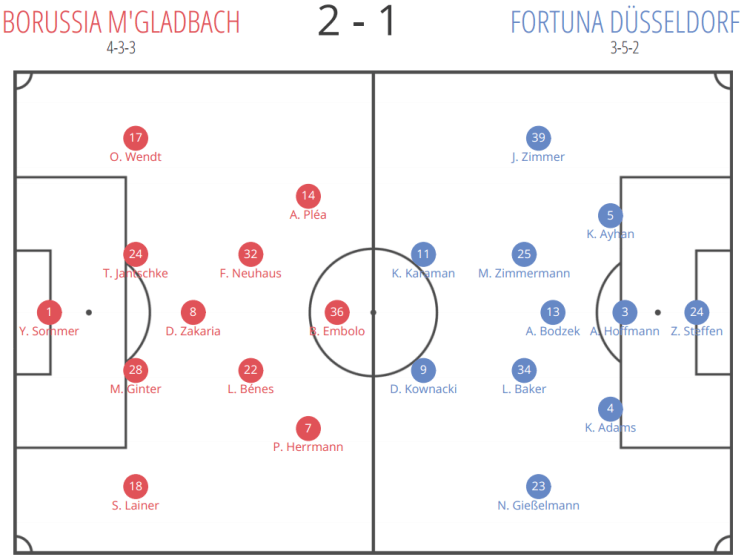
Funkel lined his team up in a 3-5-2 formation with the American Zack Steffen in goal and the back three in front of him consisted of Kasim Adams, Kaan Ayhan and André Hoffmann. Niko Gießelmann and Jean Zimmer were the wing-backs while the central midfield was occupied by Lewis Baker, Adam Bodzek and Matthias Zimmermann.
Upfront Dawid Kownacki and Kenan Karaman were the strikers.
On the other side, Yann Sommer was between the sticks and the back four was made of Stefan Lainer, Matthias Ginter, Tony Jantschke and Oscar Wendt.
Denis Zakaria, Florian Neuhaus and Lászlo Bénes were the three central midfielders while upfront Breel Embolo, Alassane Pléa and Patrick Herrmann played.
The first 10 minutes
In the opening minutes, it got visible that Fortuna truly played with a back three which turned into a back five when Gladbach were in possession. Logically, the wing-backs Gießelmann and Zimmer dropped a bit deeper in these situations to have five players in the deepest line.
However, during the first ten minutes of the game, Funkel’s team used a high and man-orientated pressing to avoid that the Fohlen could have a calm and organised build-up. They already positioned high before the goal kicks of Sommer and started to put pressure on Gladbach’s back four and Zakaria as soon as the ball was played. In light of this, it was hard for Rose’s team to play out from the back with short passing combinations and Düsseldorf’s plan got rewarded with the lead when centre-back Adams scored in the sixth minute the 1-0 with a header.
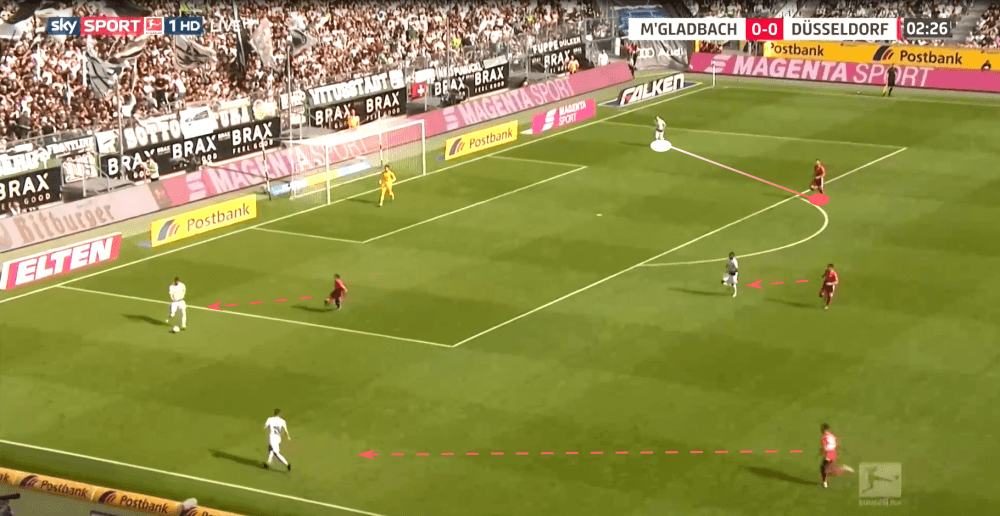
Although, not just Funkel’s team tried to utilize a high pressing, but also their opponents Gladbach did. As many expected, they didn’t start with the above showed 4-3-3 formation. They used the 4-3-1-2 and 4-1-2-1-2 respectively with Embolo behind the two strikers Herrmann and Pléa. At first glance, such minimal systematic changes aren’t a big thing since the only difference is that Embolo is positioned a bit deeper and that the two wingers are a bit more central. In the end, it’s more about the movements of the single players than their position on the tactics board or sheet. But we will see in the next paragraph of this analysis that there are one or two significant differences.
In the image below we can see a typical pressing sequence of Gladbach in the opening minutes of the game. The two strikers Pléa and Herrmann try to put pressure on one of the three centre-backs and try to use their cover shadows to wipe out their numerical disadvantage in the highest line. At the same time, the two central midfielders Neuhaus and Bénes, as well as the offensive midfielder Embolo, create numerical equality in the central midfielder against Düsseldorf’s Baker, Zimmermann and Bodzek.
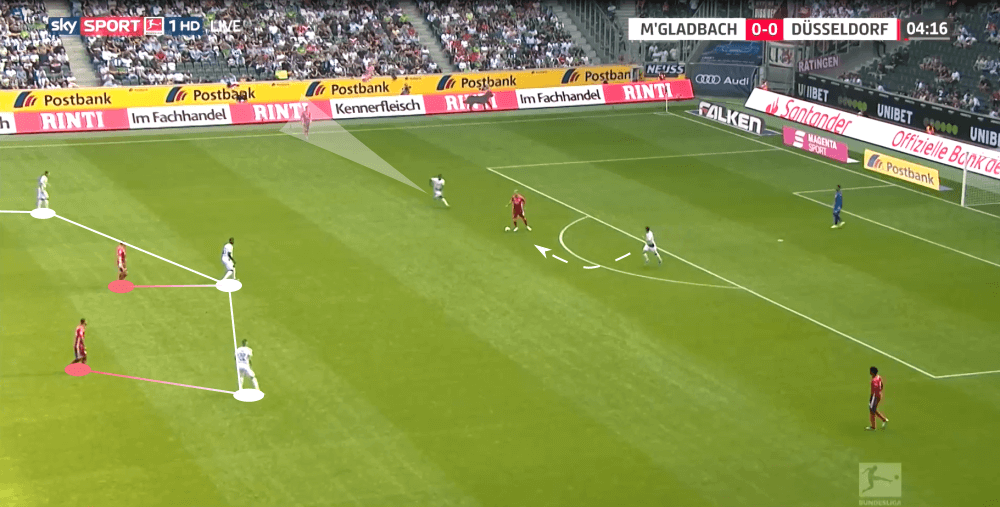
However, both teams didn’t only use a high and aggressive pressing to try to win back the ball. They also sometimes sat back a bit deeper and put pressure on their opponents about at the height of the halfway line. In the image below we can perfectly see both teams’ systems and formations respectively. Fortuna’s back three gets visible and the wing-backs are positioned a bit higher, but extremely wide. Bodzek is the deepest of the three midfielders who tries to support his teammates during the build-up and the two other central midfielders are positioned slightly higher.
On the other side, Embolo is clearly no striker, but the number 10 behind the two strikers. Zakaria is the central player in front of the back four and creates a kind of a diamond in the midfield with his three teammates
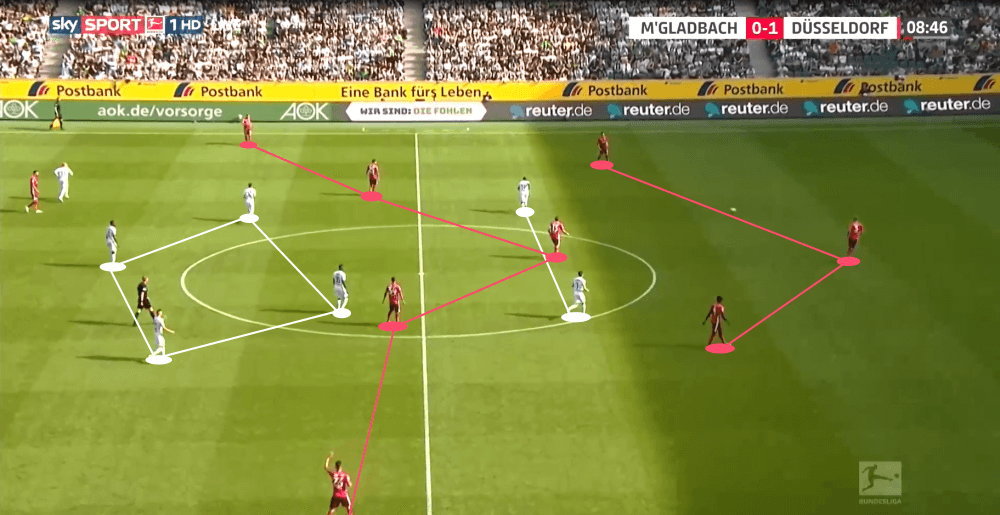
Rose’s change and Düsseldorf’s answer
However, after 10 minutes Rose changed the approach of his team and set his team up in the already shown 4-3-3 formation with Pléa and Herrmann as wingers. The German usually is an out and out right winger and so you clearly noticed that he feels more comfortable in this position. On the other hand, Pléa can play as a central striker and as a left winger. Anyway, it was all in all not a good game of the Frenchman who just won 43% of his duels and none of his shots was on goal.
Funkel reacted to this adjustment and also changed the system of his team. He modified it to a 4-2-3-1 formation in which Baker had the most interesting role. The Englishman positioned himself during the build-up a bit deeper to receive passes but when their opponents were in possession, he joined Kraman upfront to create 4-4-2 as we will see later on. You have to add that until then they played in this season just with the formations 4-4-2 and 4-2-3-1 and so it was no difficult adjustment for them. In the image below you can see the two new systems
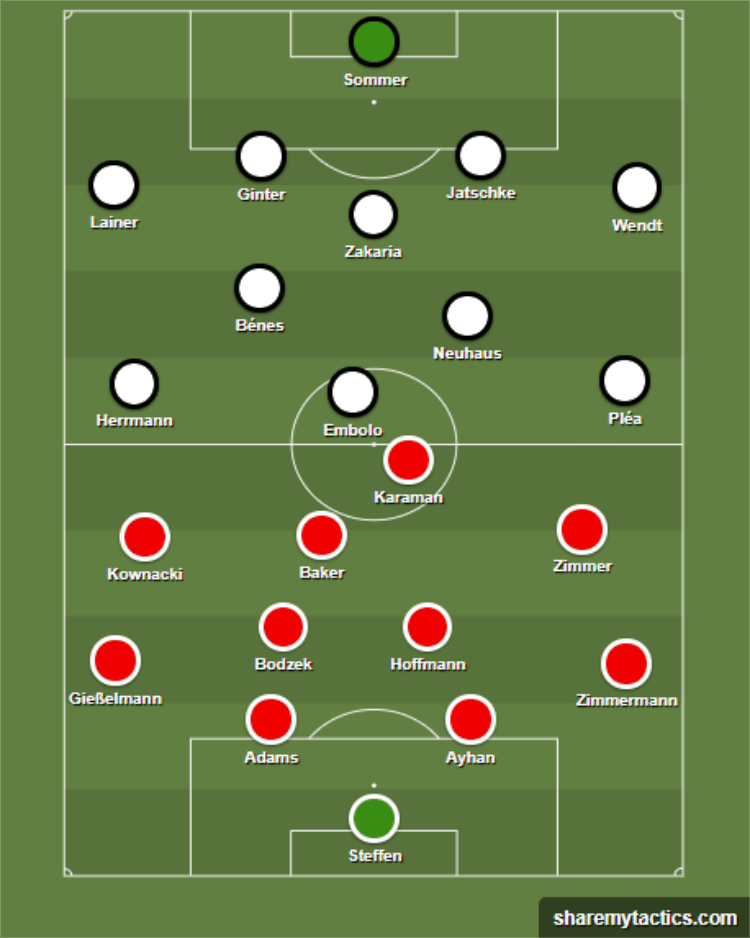
As mentioned above, Fortuna used a 4-4-2 after the first 10 minutes. From there on they didn’t really press high anymore but gave Gladbach the time and space to build up their attacks. Funkel’s team put pressure on the Fohlen when they reached about the halfway line and sometimes their pressing line was even deeper.
To create the 4-4-2, Hoffmann joined Bodzek in the central midfield, Zimmermann was the new right-back and Kownacki became the new left winger since Gießelmann had to play as the left-back.
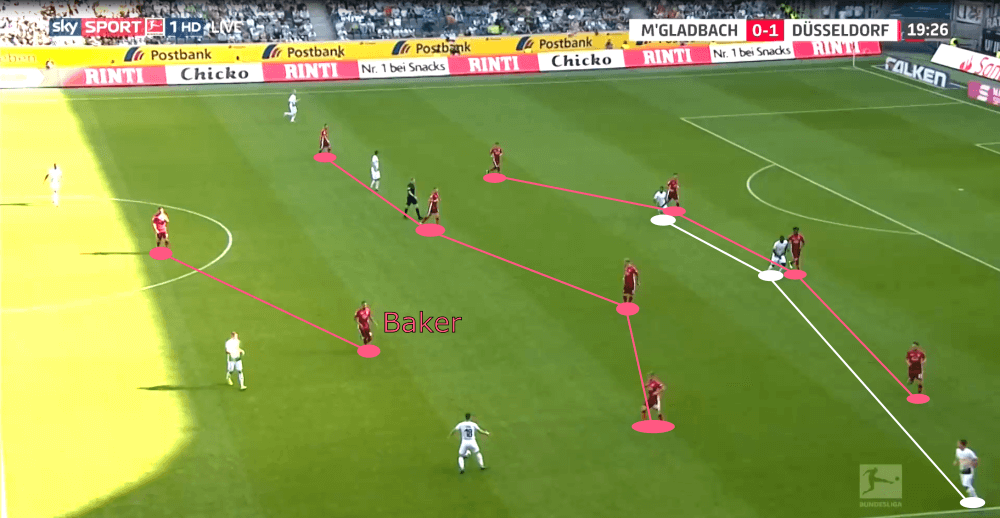
In general, Gladbach’s players had a lot of freedom and didn’t always use the same patterns during the build-up. However, quite often there was a slight asymmetric approach. As already explained, Herrmann is a natural right winger and so he often stayed wide after the adjustments in the 10th minute. Because of that, the right-back Lainer stayed a bit deeper to avoid that they occupied the same space on the wing. On the other side, Pléa often tucked in and either positioned in the half-space or joined Embolo in the centre. Due to that, Wendt was sometimes the lone man on the left wing and considering this, he had free space in front of him to push further forward than his teammate Lainer on the other side.
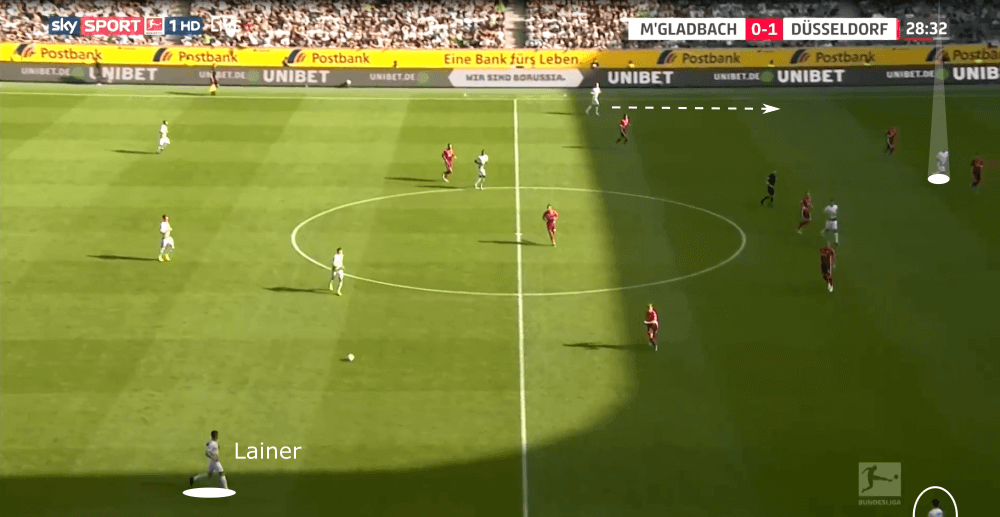
As already mentioned, Herrmann’s new position on the right wing shouldn’t make such a big difference at first glance. However, due to his wider positioning, he was able to use his greatest strength better: his pace. Because of this positioning near the touchline, it was easier for his teammates to play through passes and exploit his incredible speed.
Besides, he could make diagonal runs into the centre from there too which are extremely hard to defend against and led to several dangerous situations. All in all, the change made sense and the German winger showed a great performance in his 300th appearance for Gladbach.
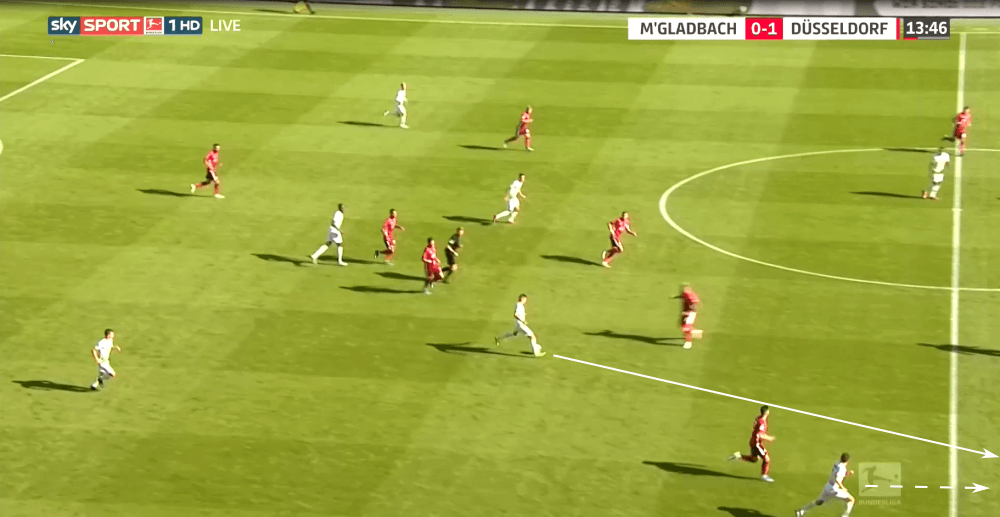
As already mentioned, due to the positioning of Herrmann, his Austrian teammate Lainer often positioned himself a bit deeper. But from there he had a few yards to pick up speed when he started one of his vertical and overlapping respectively runs. Also, he and his German teammate on the same wing harmonized. Herrmann didn’t only position wide but as already mentioned got a lot of freedom as his teammates had too. He sometimes shifted inside to occupy the half-space and so he created space for Lainer in the wide area.
In the example below, the winger is on the ball and dribbles inside to gift the right-back the time and space to make his overlapping run.
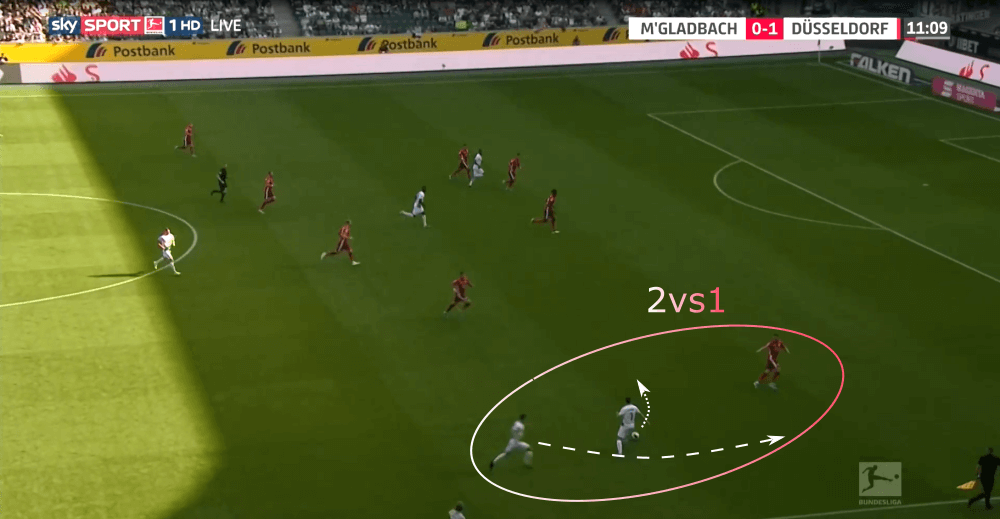
Gladbach’s dominance without any outcome
Between the 10th minute and the end of the match, Gladbach dominated the game. Even though Düsseldorf was also able to create some goalscoring opportunities, it was just a matter of time until the Fohlen would score the equalizer. This also gets visible in the stats of this game. In the 90 minutes, Gladbach had an xG of 4.53 while Düsseldorf’s value was just 1.39. In addition, they shot 11 times on the goal of Steffen while Funkel’s team just had four shots on goal.
The three central midfielders of Gladbach in this game Neuhaus, Zakaria and Bénes are all three 22 years old. One of the greatest abilities of these players is their variability which got visible in this match. Even though Bénes mostly stayed on the right side and Neuhaus on the opposing, they always showed up in different spaces. In the one moment, one of them dropped deeper to support the centre-backs to circulate the ball during the build-up and a few seconds later, he was in the final third to create a goalscoring opportunity.
In the image below, for example, Zakaria is positioned higher on the right side of the pitch while Bénes, who is usually in this space, positions himself between the two centre-backs.
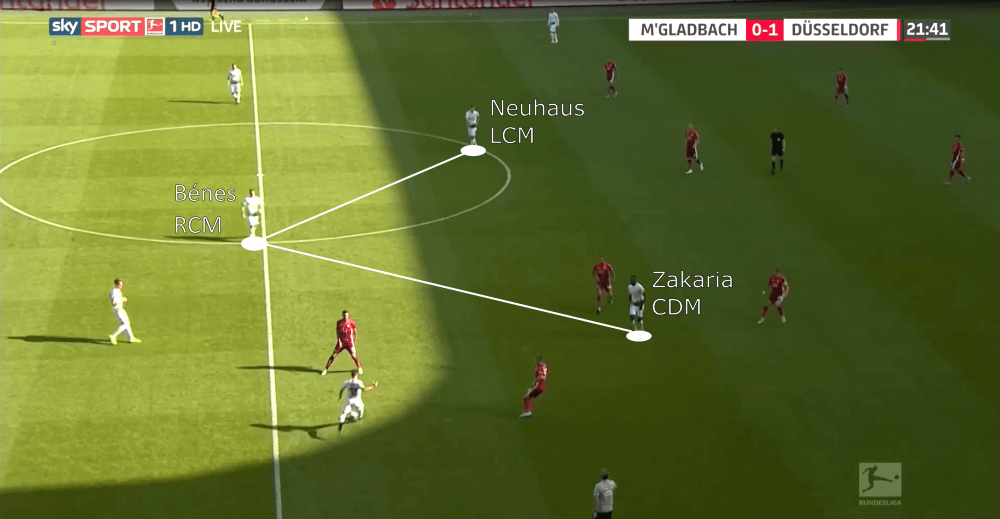
Because of the freedom of the players of Rose, they often created overloads on one side to make it hard for their opponents to defend against it. As already mentioned, Pléa rarely stayed in his positioned on the left wing and often shifted inside or in the example below he even joined Herrmann on the right wing. Adams needed to look after the Frenchman and Embolo at the same time since Gießelmann had to stay in his position because of Herrmann. This overload generated the option for Neuhaus to play a penetrating pass to the Swiss striker who wasn’t able to score in the one-on-one situation against Steffen.
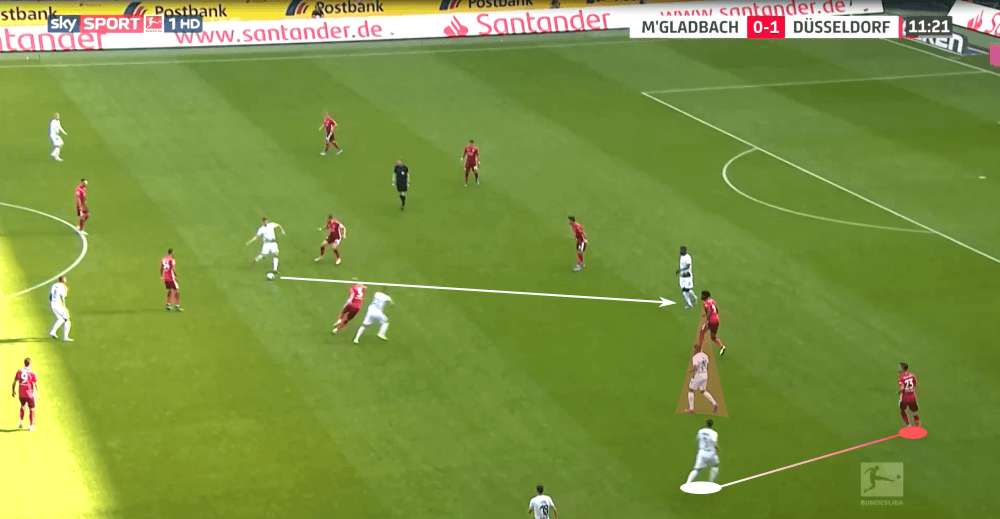
Rose is famous for his team’s intensive style of play to win back the ball as soon as they lost it. Gladbach’s players will need some time until they can execute the counter-pressing as good his team in Salzburg did, but Gladbach showed in this game some promising attempts like in the image below. In this example, they were already during the phase of their own possession so positioned, that they could immediately start the counter-pressing. Herrmann fought with the opponent for the ball who was because of that not able to play a controlled pass. As a consequence, Bénes was able to intercept the pass and start the next attack.
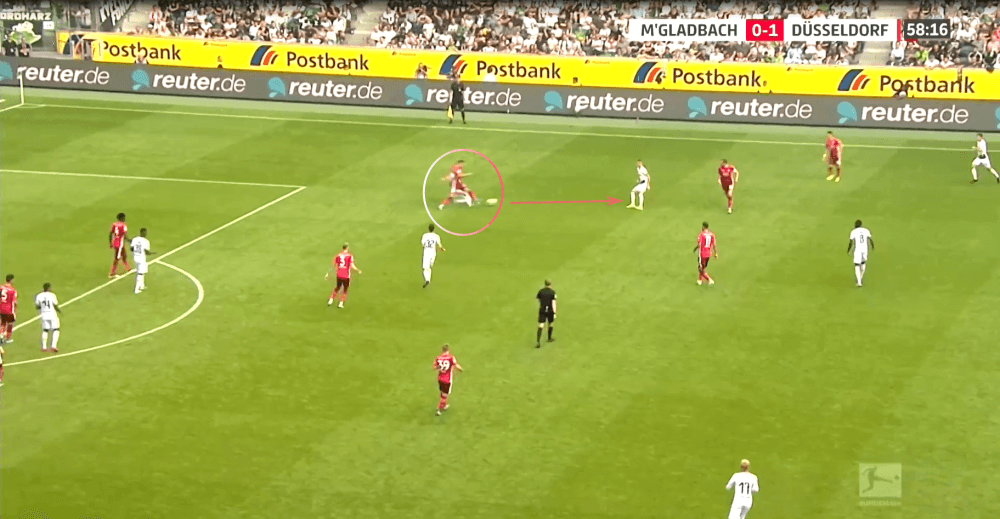
On the other side, Funkel’s team tried to get into dangerous areas with the aid of counterattacks. They had five of them during this match and two of them resulted in a shot. Since they knew that Gladbach utilizes a counterpressing, Düsseldorf tied to overcome that with vertical passes. They wasted no time to get past the players of Gladbach with these passes as shown in the example below. However, it sometimes seemed a bit overhasty like in the image below in which Baker receives a pass and wants to play a vertical pass with the second touch, but the pass is intercepted.
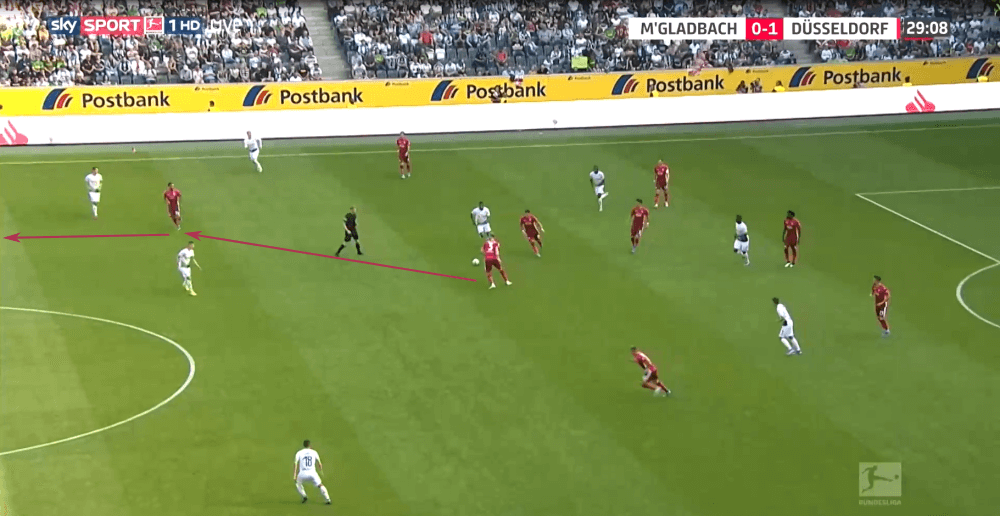
Thuram – the game changer
In the 67th Rose brought on Marcus Thuram for Pléa as a logical consequence of the weak performance of the Frenchman. The 22-years-old Thuram replaced him on the left wing and should become the man of the match. The young Frenchman was until then in every competitive match this season in the starting eleven.
He scored the equalizer in the 74th minute. Ahead of this goal, Herrmann once more positioned a bit more central to pin his opponent. Because of that, on the wing was enough space for Lainer to start a vertical run and he received a great pass by Neuhaus.
In the meantime, Thuram spotted in the middle the gap between the two centre-backs Ayhan and Adams. As soon as Neuhaus played the through pass, the Frenchman started a run in the space between them and exploited his pace to get in front of Ayhan and his strength to stay there. Lainer delivered a perfect cross and Thuram was able to score.
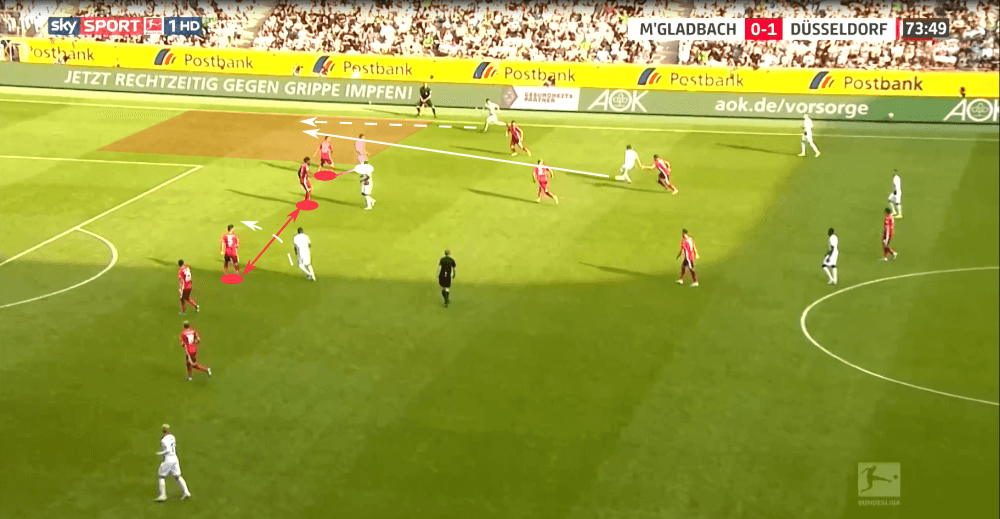
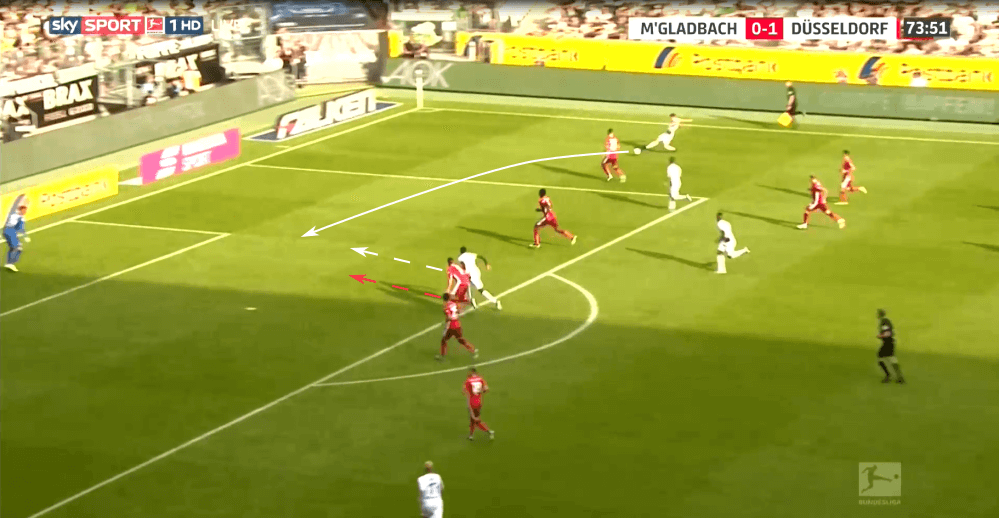
Ahead of the 2-1 the Austrian right-back once more delivered a great cross. Then Gladbach had several chances to score but weren’t able because they hit the crossbar and Steffen made an amazing save. However, in the end, Thuram was in the right position and the ball came down in front of him. From there he easily scored the 2-1 to get the win for his team.
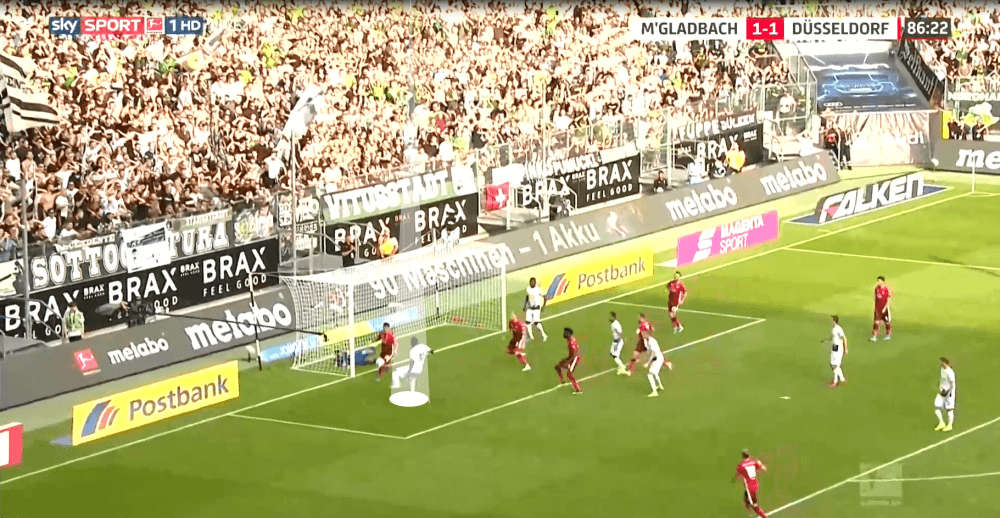
Conclusion
Even though Düsseldorf played well and defended disciplined, Rose’s team clearly deserved this win. In the end, both goals were a result of a good forward run and a great cross by Lainer. These runs were also possible because of the variable positioning of Herrmann which was a result of Gladbach’s adjustments after 10 minutes.
However, if Funkel’s team is able to continue to perform on this level, there’s no need to worry about the relegation. On the other side, the Fohlen showed the exact right reaction after the surprising high loss in the Europa League.

If you love tactical analysis, then you’ll love the digital magazines from totalfootballanalysis.com – a guaranteed 100+ pages of pure tactical analysis covering topics from the Premier League, Serie A, La Liga, Bundesliga and many, many more. Buy your copy of the August issue for just ₤4.99 here





Comments